From giant banyan trees to orchids, epiphytic cacti, and tiny succulents, a diversity of plants have aerial roots sprouting into the air above ground rather than into the soil. While some live above ground, others live on the ground and even in water.
Which plants have aerial roots?
Epiphytic plants, such as Phalaenopsis orchids, grow above ground and develop only aerial roots to anchor themselves to a surface for support and to absorb moisture and nutrients. Plants that grow on the ground, such as Banyan trees, Monstera, and many succulent species, also grow aerial roots but the function is mainly to absorb moisture in the air.
In this article, we will look at 18 examples of common plants with aerial roots and look at what aerial roots are in terms of their appearance, their location on the plant, and their various functions.
Let’s begin.
Which plants have aerial roots?
All epiphytes (or plants that grow above ground) have aerial roots, but not all plants that have aerial roots are epiphytic.
Epiphytes are also known as “air plants” because they don’t grow in the ground in soil but grow above ground in the air on other plants (mostly trees).
They are not parasitic, meaning they do not harm the host plant. They rely on the tree only for anchorage and structural support, surviving by their aerial roots that absorb nutrients and moisture from the humid air, rain, or debris around it.
For epiphytes, their roots are always aerial roots.
However, many plants with aerial roots grow on the ground and are not air plants. These plants have both ground roots and aerial roots.
For instance, many succulents like Kalanchoe, Jelly bean plant, etc. grow in soil and often develop fine aerial roots along the stem; Tropical plants such as Monstera, Pothos, Philodendron, and even trees like the banyan fig tree (Ficus microcarpa) grow on the ground and also develop aerial roots from their stems or woody branches.
Examples of plants with aerial roots
1. Rhipsalis cassutha (Spaghetti Cactus)
Rhipsalis cassutha (Spaghetti Cactus) is an epiphytic cactus. Contrary to the type of desert cactus that are most commonly known, epiphytic cacti come from the rainforests.
Epiphytic cacti do not have spikes and are treasured for their beautiful blooms. They have long, trailing leaves and stems that can climb up or drape down a tree branch absorbing the moisture and nutrients, making them a popular choice for hanging baskets.
Ripsalis cacti are examples of epiphytic cacti. Take a look at our list of epiphytic cacti.
2. Monstera
Monstera is a genus of nearly 50 species that are both terrestrial and epiphytic. The most commonly seen species is the Monstera Deliciosa (Swiss Cheese plant) which is kept as a houseplant.
Their roots are brown or greenish and appear when the plant reaches a certain size and age. More aerial roots will appear as the plant continues to grow so if not trimmed, the aerial roots can become really dense over time. They start soft but eventually harden.
The roots help anchor the Monstera to surfaces and absorb moisture from the air. They grow vigorously, hanging several feet below the plant, and the oldest ones may eventually touch the soil.
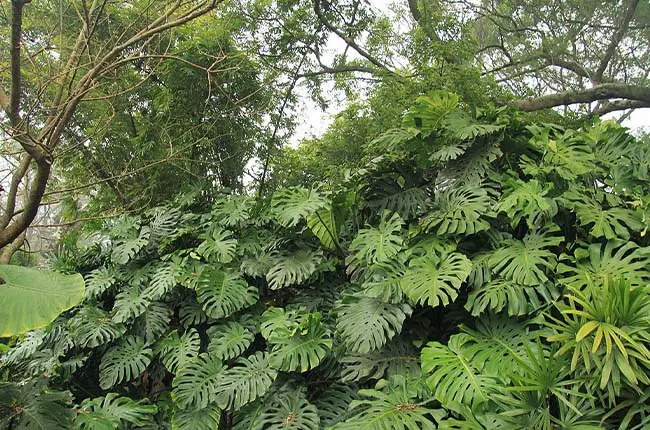
(乌拉跨氪, CC BY-SA 3.0, via Wikimedia Commons)
3. Philodendron
In the Philodendron genus, a considerable number of its species have aerial roots. Climbing philodendrons typically have small delicate aerial roots meant to attach the plant to surfaces as it climbs.
The non-climbing philodendrons produce larger, thicker (about half-inch in diameter) aerial roots that can absorb water and nutrients for the plant. They are usually brown and just a couple of feet long, growing in different directions.

(Filo gèn’, CC BY-SA 4.0, via Wikimedia Commons)
4. Pothos
There are many varieties of pothos, and virtually all of them are epiphytes.
As such, pothos plants frequently develop aerial roots to help them cling onto surfaces as it grows. The aerial roots may also absorb moisture from the atmosphere.
Pothos aerial roots start as thick nubs on the stems that will eventually grow into brown tendrils as it progresses. The roots typically do not become too dense as they’re spread out along the stem. The roots grow in different directions, some climbing up surfaces, while others grow downward.
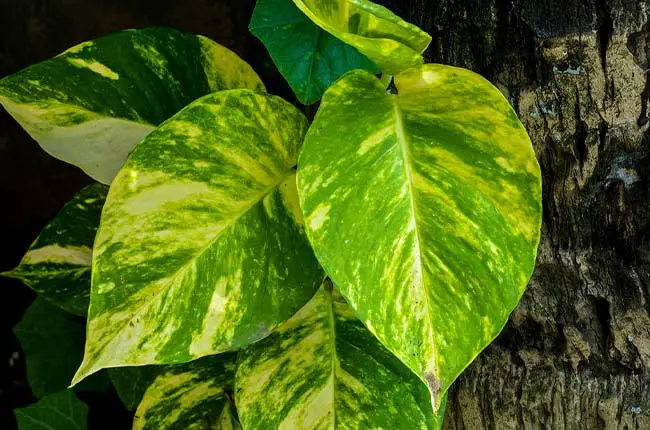
(Photo: Joydeep / Wikimedia Commons)
5. Phalaenopsis (Moth orchid)
Not all orchids are epiphytes, but Phalaenopsis orchids are epiphytic.
As epiphytes, these orchids have aerial roots to attach themselves to other surfaces and to absorb moisture and nutrients from the air.
The roots resemble white tendrils growing in all directions. The whiteness is due to a spongy tissue called velamen, which gives the roots a white/silvery look when dry, but green if wet. Velamen is what allows the orchid to absorb moisture and nutrients from the air. (Zotz et al., 2013)
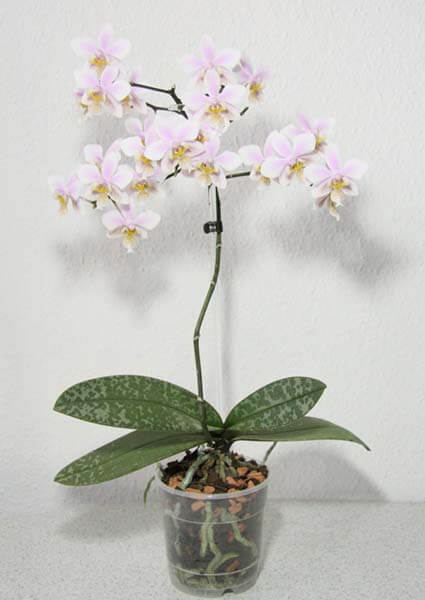
6. Brassia caudata (Spider orchid)
Brassia is a genus of epiphytic orchids. They are known for their peculiar-shaped flowers which give them the appearance of a spider.
The roots are similar to those of moth orchids, being thick, covered in velamen, and growing in different directions. They help to anchor the spider orchid and to absorb moisture
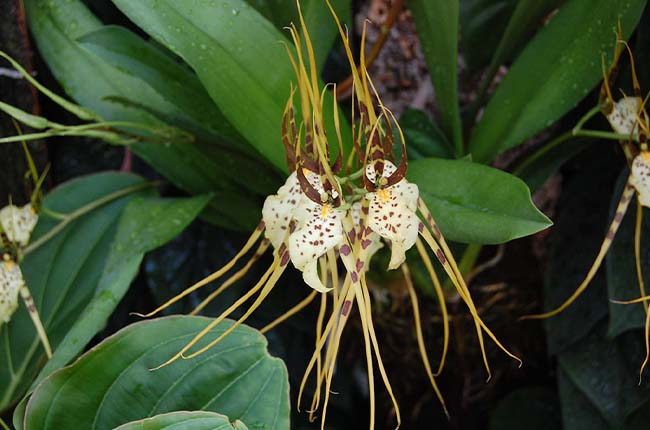
(Jan Witowski, CC BY-SA 3.0, via Wikimedia Commons)
7. Succulents with long stems
Some succulents, particularly those with long stems like jelly bean sedums, kalanchoe, echeveria, etc., can develop aerial roots in addition to the underground roots.
Aerial roots usually appear when the plant doesn’t get enough water from the soil, so they use aerial roots to absorb moisture from the air.
Succulent aerial roots are soft, white (or pale pink) thin whiskers rarely more than a few inches long. They grow in different directions along the stem, and can sometimes be so much that they make the plant look unsightly, in which case they can be clipped off without affecting the succulent.
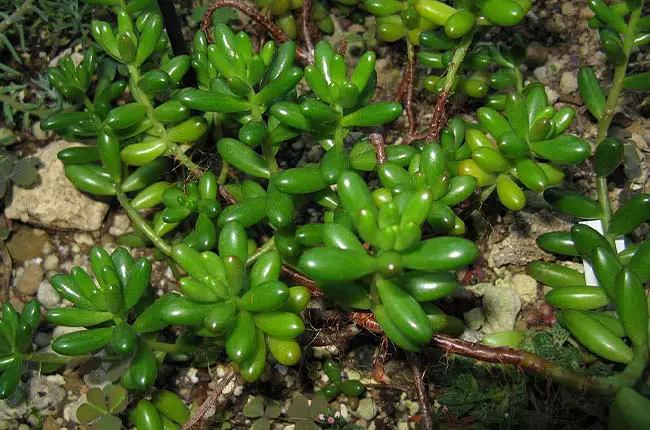
(KENPEI, CC BY 3.0, via Wikimedia Commons
8. Hoya
Most Hoyas are vining epiphytes, and as such have aerial roots.
The aerial roots support the plant as it climbs up a tree, wall, or trellis. They can also absorb water and nutrients from the air.
In highly humid areas, some Hoyas tend to send out more aerial roots,
The roots are green and slender and they can get several inches long. They generally grow downward, hanging under the stems.
Despite the similarities, Hoyas are not orchids.
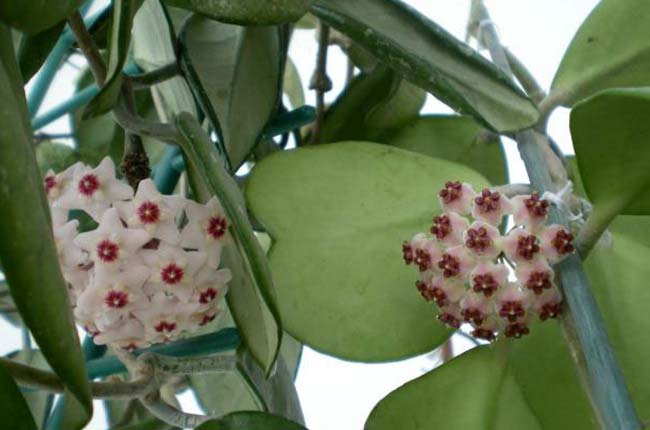
(Hobbykafe, CC BY-SA 3.0, via Wikimedia Commons )
8. Vines
Some vines use leafless stems to curl up around poles and wires, others use adhesive pads to cling to surfaces. But certain vines like Toxicodendron radicans (poison ivy), Hedera helix (common ivy), Baltic ivy, Virginia creeper, and climbing hydrangea have aerial roots they use to cling onto surfaces as they climb.
The aerial roots grow from the sides of the stems, appearing as small greenish, yellow, or brown tendrils along the climbing stem, sometimes giving the stem a hairy appearance.
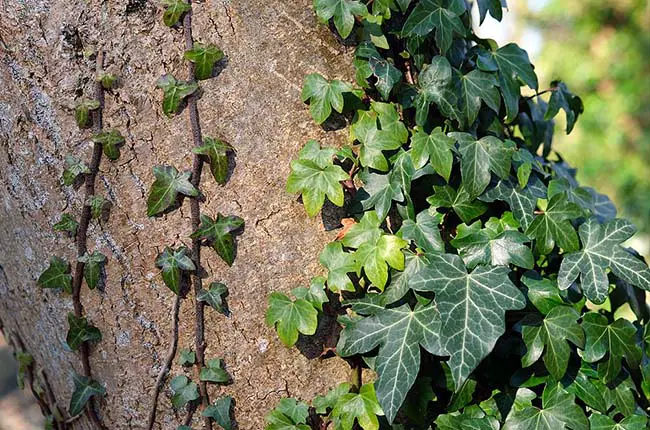
(kallerna, CC BY-SA 4.0, via Wikimedia Commons)
10. Tillandsia usneoides (Spanish moss)
Spanish moss (Tillandsia usneoides) is an epiphytic bromeliad which has aerial roots.
The roots are mainly for anchoring the bromeliad to trees and other surfaces.
The uptake of water and nutrients is done by the leaves using hair-like structures called trichomes.
The aerial roots of epiphytic bromeliads are found at the base of the plant. They are usually thin, brown, and some inches long. There’s usually a moderate density of these roots anchoring the plant to a surface or structure.
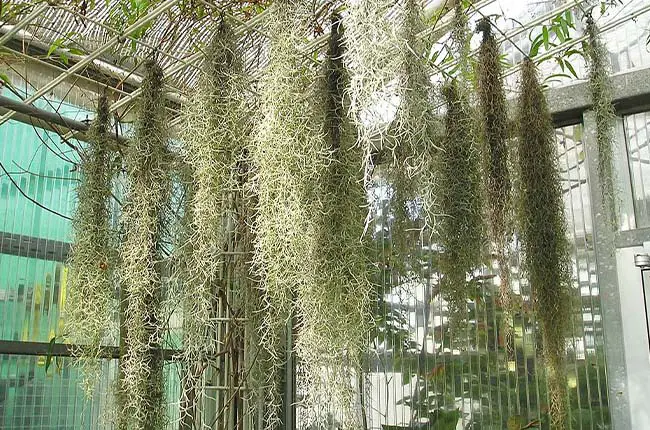
(Maja Dumat, CC BY 2.0, via Wikimedia Commons)
11. Tillandsias
Tillandsias, such as the pink quill, sky plant, and tillandsia stricta, are all epiphytic bromeliads, and so use their aerial roots majorly for anchorage. Moisture and nutrient absorption are handled by the leaves.
Tillandsia aerial roots are similar to other bromeliads– brown, thin, and long roots at the base of the plant. The roots are many and often densely packed.
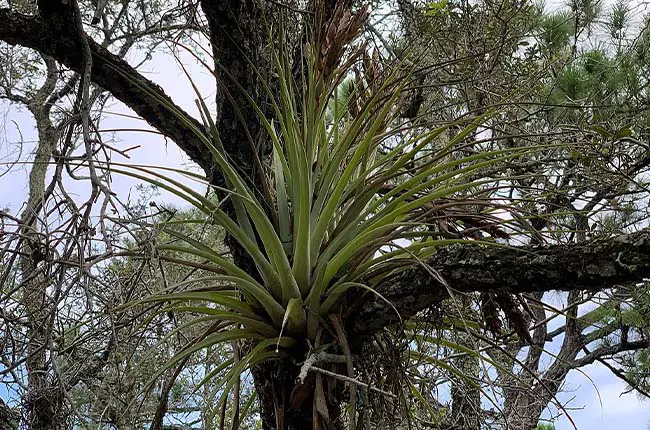
(P,TO 19104, CC BY-SA 3.0, via Wikimedia Commons)
12. Staghorn fern
Many ferns including the staghorn, strap, and blue star ferns are epiphytes. They grow above ground, so their roots are aerial roots that they use to cling to trees, walls, and other surfaces.
Some ferns like the Boston fern (this fern can be grown terrestrially or as an epiphyte) produce leafless tendrils, which some people might mistake for aerial roots. But those are stolons (or long offshoots), and they can be used to propagate ferns since ferns don’t have flowers or seeds.
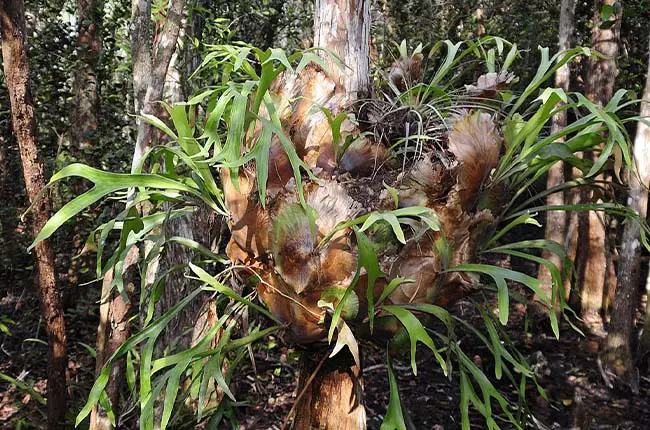
(MikesMegapixels, CC BY 3.0, via Wikimedia Commons)
13. Banyan fig tree (ficus)
The banyan fig tree has prominent aerial roots that grow downward from underneath the branches.
When the aerial roots eventually touch the ground, they become supportive woody trunks. These types of aerial roots are also called prop roots.
Other types of figs also show aerial roots. In the case of strangler figs, the plant starts as an epiphyte growing with a host tree.
As it matures it sends down several aerial roots along the tree trunk until they reach the ground, taking root. At this point, the host tree would have been enveloped by several thick woody aerial roots from the fig.
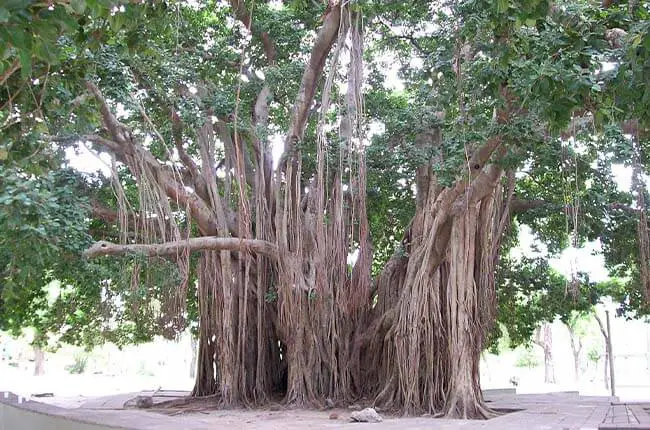
(Dario Alpern, CC BY-SA 3.0, via Wikimedia Commons)
14. Mangroves
Mangroves are tropical trees that grow in swamps where the soil is rather soft and there isn’t any oxygen in the soil for the roots.
Red mangroves send out thick woody aerial prop roots from the trunk and branches to better support the plant in the soft swamp soil. Additionally, these roots also take in oxygen for the plants.
Black mangroves do not have prop roots, but small vertical air roots can be seen around the trunk of the tree. These roots are called pneumatophores, and they extend up from the underground roots and absorb oxygen for the tree.

(Riandi, CC BY-SA 3.0, via Wikimedia Commons)
15. Metrosideros
Metrosideros is a genus comprising several plants, many of which have aerial roots.
Some Metrosideros (e.g. Robusta) act like a strangler fig, sending down a thick aerial root along the trunk of the host tree. Unlike strangler figs, the Robusta root doesn’t completely enclose the host tree, but remains to one side, only branching out as it nears the ground.
Another Metrosideros, the New Zealand Christmas tree produces thin, long, fibrous, aerial roots that hang from the branches and trunk. The roots are reddish brown, and so many that they often become mated and trap water droplets for the plant.
16. Pandanus
Pandanus is a genus of tropical trees that frequently grow along riverbanks, marshes, and coastlines. Trees in this genus are like the red mangroves – they have many large thick, woody, prop aerial roots extending from the trunk and stems to the ground.
The aerial roots help to support and keep the plant in place, especially in erosion-prone areas. At the same time, they transport air to the underground roots. When the aerial roots grow into the earth they branch and become like regular water and nutrient-absorbing roots.

(S Molteno, CC BY-SA 4.0, via Wikimedia Commons)
17. Schefflera
Schefflera, particularly the dwarf Schefflera or dwarf umbrella tree is a tropical tree that infrequently develops aerial roots.
The roots are yellow, long, and fairly thick. They grow from the sides of the stems, and usually appear when the plant’s growth and roots are constricted and so it attempts to use the aerial roots to absorb moisture from the air.
Humidity may also make the plant send out aerial roots, and gardeners find ways to increase humidity around their Schefflera to influence the growth of aerial roots.
18. Brassaia
Brassaia is a close relative of the dwarf umbrella tree. It can also grow aerial roots much like that of the dwarf umbrella tree.
Similar to its dwarf relative, the growth of aerial roots on Brassaia is triggered by insufficient care, and high humidity.

(coenobita, CC BY 4.0, via Wikimedia Commons)
19. Grapevines (Viticea)
Members of the Vitaceae family can grow aerial roots, although this doesn’t happen frequently. The aerial roots, which usually have a brownish-orange color, are long and slim, growing mostly from the underside of branches, and less frequently from the sides.
It’s believed that the aerial roots are brought in by cold injury to the branches and possibly wet and humid growing conditions.
Functions of aerial roots
Aerial roots can serve a number of functions like anchorage and support, water and nutrient uptake, and gas exchange. The exact role they play varies from plant to plant.
Support and anchorage
For epiphytes such as epiphytic orchids, the major purpose of aerial roots is to anchor the plant to the surface it’s growing on; this could be a tree, wall, rock, or trellis. The aerial roots attach firmly to the surface so that strong winds or animals do not easily push off the plant.
Similarly, aerial roots can also act as support for certain plants. They grow downward from the branches, eventually touching the soil and working as secondary tree trunks that support the heavy branches. Aerial roots like these are referred to as prop roots and are found on the many tropical fig trees and mangrove trees.
Water and nutrient uptake
Aerial roots can also absorb moisture and dissolved minerals in moist air, rain, dew, or water droplets that fall from the tree canopy above.
This is the case for most small houseplants such as succulents. They send out thin, aerial roots from their stems when they do not get enough water from the soil or when the area is very humid. The aerial roots will help absorb moisture from the air to meet the plant’s water needs.
Gas exchange (breathing)
Aerial roots can also be used for gas exchange, allowing the plant to take in oxygen. Aerial roots that work like this are called pneumatophores and are found mainly on black mangrove trees that grow in swampy, waterlogged soils.
There is little to no oxygen for underground roots in waterlogged soils, so the plant grows these specialized aerial roots that extend out of the anaerobic soil upward from the covered in small pores that can take in oxygen and transport it to the rest of the plant. (University of Florida, 2018)
Where are aerial roots found?
Aerial roots, also known as “air roots”, are basically roots that grow above ground and are exposed to the air.
They are almost always adventitious roots, which are roots that don’t develop from root tissue. Instead, they grow from nodes, internodes, stems, leaves, or branches.
They can sprout from herbaceous plant stems like those of epiphytic orchids, Monstera Deliciosa (Swiss Cheese plant), Pothos, succulents, as well as from woody stems or trunks of trees such as Ficus Bonsai.
The location of aerial roots depends on the needs of the plant. In the case of epiphytes, which inhabit tropical and temperate rainforests, aerial roots sprout from the base of the plant to attach to the host plant and absorb moisture from the humid air. The roots also take in nutrients from the organic debris on the host tree.
Their color changes when they are moist or dry. For epiphytic orchids, their roots are silvery-white when dry and green when moist. For the aerial roots of Pothos, they appear white when moist and brown when dry.
Conclusion
Aerial roots are adventitious roots that grow above ground. They can be found in epiphytes like Phalaenopsis orchids, where they serve to anchor the plant to the host tree and absorb moisture and nutrients from the environment.
Aerial roots can also be seen on plants that grow on the ground, such as many houseplants and some succulents, where their presence serves to absorb moisture in the air.
In trees and mangroves, aerial prop roots support and stabilize the tree in the soft swampy soil. They also absorb and transport oxygen to the underground roots buried in the soil.
Related
20 Epiphytic Cactus (Perfect For Hanging Baskets)
Why My Succulent Has Aerial Roots? (Is It Bad?)
4 Effective Ways to Promote Aerial Roots (Explained)
References
University of Florida (n.d.). Bromeliad Biota – The Bromeliads.
Dawson, J. W. (1967, May). A growth habit comparison of Metrosideros and Ficus | NZETC. Victoria University of Wellington.
University of Florida (n.d.). Epiphytes – University of Florida, Institute of Food and Agricultural Sciences.
University of Kentucky (n.d.). Ferns.
University of Florida. (2018, October 3). Mangrove Adaptations. Florida Museum.
University of Illinois Extension (n.d.). Methods of Attachment | Vines: Climbers & Twiners
Stafne, E. (2019, June 20). Aerial Root Formation in Grapevines. Grape Community of Practice.
Zotz, G., & Winkler, U. (2013, January 6). Aerial roots of epiphytic orchids: the velamen radicum and its role in water and nutrient uptake. Oecologia, 171(3), 733–741.
Zona. (2002). Pandanus Primer. Fairchild Tropical Garden Herbarium.
- 5 Ways To Break Seed Dormancy: Which is the Best? - May 22, 2022
- Ants in Garden: 7 Ways to Remove Them (Naturally) - April 23, 2022
- Top 19 Plants with Aerial Roots (With Pictures) - April 17, 2022

